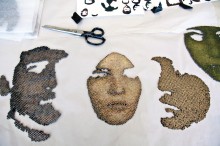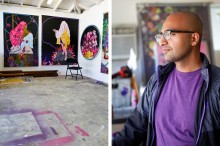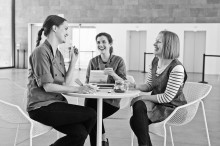Asad Faulwell
Art happens in unlikely places. When Klea and I began IN THE MAKE this was something we suspected to be true, and with now close to three years worth of studio visits under our belt, I’d venture to say it’s a fact— art is made in all kinds of places and circumstances, often in defiance of expectations and despite real logistical challenges. This notion was verified even further this spring on our WESTERN EDGE trip— with each new town we traveled through on our tour, we visited artists in outlying regions, making intelligent and serious work in their basements, garages, and living rooms. And no matter how far-flung the location or how makeshift the studio, still the intention and dedication of these artists and their process remained focused and uncompromised.
On our way to LA from the desert town of Calipatria, we stopped into Newport Beach to visit Asad who works out of the garage attached to the condo he lives in. I only really knew two things about Newport Beach when we arrived: it’s in Orange County and overall it’s a pretty affluent town. Truth be told, those are still the only two things I know about Newport Beach… well, except now I know amidst cookie-cutter condominiums, fancy cars, and breezy palm trees, there is powerful and vibrant work being made about the almost-forgotten Algerian women who struggled alongside their male counterparts between 1954-1962 in an effort to end the French occupation.
Inspired by Gillo Pontecorvo’s 1966 film The Battle of Algiers, over the last few years Asad has produced a series of works that pay homage to these Algerian female freedom fighters, who were often called upon to plant bombs in the French section of Algiers and when caught suffered brutal consequences. Asad’s collaged paintings are based on photographs he has found of these women, taken during their lifetimes— some are images from when they were on trial in the French courts and some are photos from when they were younger and not yet involved in the Algerian War of Independence. In his paintings the women’s faces are gray, hollowed-out looking, and almost ghostly, which create a haunting and unnerving experience for the viewer. That otherworldly feeling is further exaggerated by Asad’s use of repeated patterns and semi-religious imagery, which in a way make the works resemble shrines or alters, inviting the viewer to wonder about, question, and commemorate… if not the women themselves, at least this time in history.
What I find most thrilling is that a man has lent his voice to the story of these women, a man across the globe, from a different generation, who is not Algerian, saw that this piece of history mattered enough not to be lost.
How would you describe your subject matter or the content of your work?
The subjects are all combatants from The Algerian War of Independence. I came to this subject through the film “The Battle of Algiers” and through viewing Orientalist works by Delacroix and the subsequent works by Matisse and Picasso. There was this long history of painting portraits of anonymous Algerian women in harems. I saw an area where I could comment on art history, history, literal and intellectual colonialism while also commenting on gender.
What mediums do you work with?
Primarily acrylic but also paper, oil and pins, always on canvas.
Your work references traditional Islamic art and historical events in the Middle East and I imagine you conduct extensive research– how do you zero in on specific elements or periods to focus on?
I try to reference all types of religious artwork, anything that is meant to show reverence or beatify an individual. I had done pieces relating to various post-colonial movements and periods in The Middle East during grad school and in the period immediately after grad school. I think that this period of history still directly impacts what happens today, so for this reason I think it is an important era to discuss. Around 2008 I saw “The Battle of Algiers” which led to the current body of work. I spent 2 years researching the actual battle and its combatants and in 2010 started making work based on this research. I still do research and still find new information or new images that I did not have before, so it is an ongoing process.
Female figures predominate in your work— can you tell us more about that?
All of the women in the work were combatants in The Battle of Algiers, some of whom were depicted in the Pontecorvo film. After significant research I was able to find the names, bios and images of the actual women who took part in the battle. These women were recruited because they could pass through French check points more easily and could navigate the French quarter of Algiers without drawing suspicion. Many of them carried out bomb attacks in the French quarter targeting police, military and civilians. Almost all of them were captured and arrested by the French and a few were killed in battle. Those who were captured were subjected to brutal torture and sentenced to death before being pardoned at the end of the war. They then returned to Algiers only to find it incredibly difficult to integrate back into society. They were labeled by many as tainted since they had spent so much time with men and had been tortured by the French. They also found that women’s rights in Algeria were eroding. Some of them stayed in Algeria and campaigned for women’s rights, others ironically ended up moving to France. In many ways these women remind of the Zouaves who were Algerian men who fought in the French Army. These men thought that they were staking their claim for equality by fighting in the French Army. There is no doubt these women thought they were staking their claim for equality in post-colonial Algeria by doing their part to earn independence.
Do you see your work as autobiographical at all?
In a very disconnected way I think everyone’s work is autobiographical. I make work about what interests me which in a way says something about me.
What are you presently inspired by— are there particular things you are reading, listening to or looking at to fuel your work?
Reading does inspire me and does get me excited about making work. I’ve been reading a lot more lately and even if the reading is completely unrelated to my work it does get me excited about being in the studio. The last thing I read was The Trial by Franz Kafka. Also attending shows or looking through art books can provide a spark. I like looking at work that doesn’t relate to my work in any direct way, I feel like that is where I learn the most. Certainly, as was the case with “The Battle of Algiers” — a movie can inspire me. More than anything I love to listen to music while I work. I will listen to the same album over and over again in the studio. I like listening to complete albums start to finish while I work. I’ve probably listened to Frances the Mute by The Mars Volta like 100+ times while working. Reading, viewing or listening to work by people that I admire makes me want to be a better artist and I think that is where the influence comes from.
What does having a physical space to make art in mean for your process, and how do you make your space work for you?
When I first got out of school I couldn’t afford a studio so I worked on the floor in a bedroom. I could only do small things and it was a mess. Once I was able to have a set studio with good lighting and open space I certainly became much more productive and my work became more expansive, more colorful and more complex. I try to keep my space as convenient as possible. I want all my supplies to be within arm’s reach so that I do not need to go look for anything. It certainly doesn’t always look clean but as long as I know where everything is I feel good in the studio.
Is there something you are currently working on, or are excited about starting that you can tell us about?
Yes, I am currently starting a large diptych for the “Les Femmes d’Alger” series. I am also very excited about planning a piece that I have been thinking about for a couple years. It involves the manifestos of various post-colonial dictators. The manifesto may stand on its own as an illuminated text or I may embed the manifesto in to a larger painting. I am not 100 percent clear on how this work will play out but it will mark a shift in subject matter and it will be the first time in a long time that I will be making work about men. I would like to start on this body of work this year.
How do you navigate the art world?
I actually don’t do a ton of navigating, at least in Los Angeles. I have a couple friends that I do studio visits with regularly. I have a couple dealers I work with. I don’t really go to a lot of openings unless I know somebody in the show. In a way it’s kind of strange that I live in the LA area and have a studio in LA but I show my work mostly in other places. I guess if I showed more frequently in LA I would be more active in the art scene then I am. I have always felt like it’s most important to spend most of my available time working. So usually if I am going to choose between going to an opening or working, I will work.
Do you have a motto?
I guess that hard work pays off. Most of the art making process is frustrating but you have to grind through that to get to that moment where everything clicks. Those moments are incredibly rewarding.
Are you involved in any upcoming shows or events? Where and when?
I will be having my first solo show with Lawrie/Shabibi Gallery in Dubai in January 2014. I will also be doing Art Dubai with Lawrie/Shabibi in March 2014 and then will have my third solo show with Kravets/Wehby Gallery in New York in the Fall of 2014.
To see more of Asad’s work:
www.asad-faulwell.com
www.asadfaulwell.blogspot.com
His New York gallery: www.kravetswehbygallery.com
His Dubai gallery: www.lawrieshabibi.com




